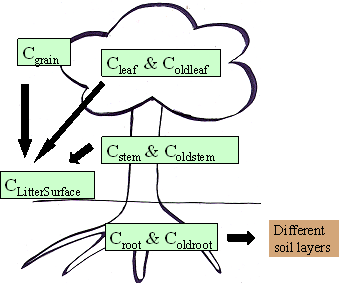Litterfall
As a plant grows older some parts of it will eventually die and form litter. In the model this litter fall is an ongoing process that starts as soon as the plant comes to existence and will continue as long as the plant is still alive (Figure 5.3).
Figure 5.3. Litterfall in a perennial plant.
The leaves fall to the ground at a continuous rate:
The leaf litter rate function, f(lLc), can be calculated in two different ways regulated by the switch Litter fall dynamics:
• Static: if
“static” is chosen or if TSum < tL1 (5.60)
(5.60)
• F(tempsum):
if “f(GrowthTempSum)” or “f(DormingTempSum)” are chosen and TSum > tL1
where tL1, tL2, lLc1 and lLc2 are parameters and TSum is either the accumulated temperature excess over the temperature threshold value for emergence (the “f(GrowthTempSum)” alternative) or the so called “dorming” temperature sum, TDormSum, (the “f(DormingTempSum)” alternative). TDormSum is calculated at the end to the growing season when the air temperature is below +5 °C as the accumulated difference between +5 °C and Ta. The stem and grain litter rate is calculated analogously with the parameters tS1, tS2, lSc1 and lSc2, and tG1, tG2, lGc1 and lGc2. See viewing function Litter fall.
Roots also have dying parts that will be lost from the plant and form soil litter. In this case the litter will go straight into the soil litter compartments but is otherwise analogous to the litter fall from leaves:
The root litter rate function, f(lRc), can be calculated in two ways regulated by the switch Litter fall dynamics, with eq. (5.60) or eq. (5.61) by exchanging the parameters tL1, tL2, lLc1 and lLc2 to tR1, tR2, lRc1 and lRc2.
Litter fall from roots, leaves and stems in the “old” biomass in perennial plants are calculated similarly to the “new” biomass but with the important exception that some of the old leaves may be retained:
where or soldleaf is a scaling factor. The new leaf litter fall is also multiplied by the scaling factor, snewleaf, when litter fall from perennial plants is estimated. The scaling factors can be used as “fractions” in order to determine in what proportions the leaves will fall from the new and the old pools respectively.
CRemainLeaf is the fraction of the whole COldLeaf pool that will be excluded from the calculation of the litterfall from the old leaves. This fraction is dependent on the maximum leaf lifetime, llife:
The litter fall from perennial plants for stems and roots is calculated analogously.




